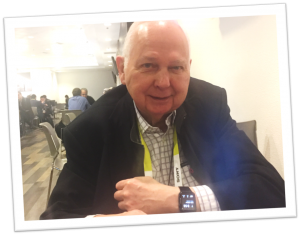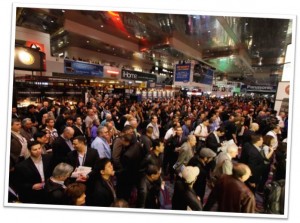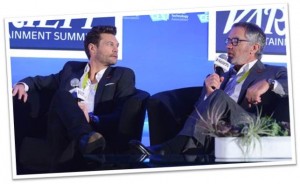For those of you reading this who have been lucky enough to attend the Consumer Electronics Show in Las Vegas this year or in the past, you’ll know exactly where I’m headed. On the other hand, those of you who have never had (or taken) the opportunity to make the January trek to CES, this post’s for you.

But first let’s start with one of my rituals at CES – breakfast with the Oracle of Bala Cynwyd, Jerry Lee. I shared bacon and scrambled eggs with Jerry at Lucky’s inside the Las Vegas Convention Center last week.
This was my seventh CES. It was Jerry’s 48th – in a row. I asked him a few years ago why he’s made it a point to attend this event year after year. The simple explanation: “I don’t want to miss the future.”
The future was very much on display at CES 2016, and several major themes were very apparent. Among the 3,500 exhibitors, automotive showed up bigger than ever. That’s a major trend, and within that silo, autonomous driving was the major buzz, as you strolled from Ford to Toyota to Chevy to Kia.
Other categories that were frequently seen and talked about at CES included drones, 3D printers, wearables (fitness trackers, smartwatches), and virtual reality.
But the buzz of CES this year wasn’t about hot, new devices. We’re entering a new phase where it’s less about gadgets for gadgets’ sake. As Shawn Dubravac (CTA’s Chief Economist) told attendees at his keynote, it used to be about what was technologically possible. Today, it revolves around what is technologically meaningful.
The focus now is on the ways in which the science, engineering, and technology at CES can have societal impact, solve consumer problems, help others, and even make the world a greener, more sustainable place. Autonomous driving fall into all of those categories. One of its eventual benefits will be the ability of self-driving cars to transport seniors and those with special needs from Point A to Point B.
Yes, CES is still about “stuff,” and there was no shortage of cool gadgetry and head-shaking devices, but there’s a shift underway that puts the consumer at the center of the strategy.
Another overriding theme revolves around how innovation has become even more democratized. Yes, Ford, GM, Toyota, Kia and others are committing billions (with a B) to initiatives like shared mobility and autonomous driving. But small, bootstrapping entrepreneurs are taking big technology concepts – like 3D printers, drones, and VR – and using them to solve a variety of important and sometimes trivial problems. Innovations that companies like Apple, Google, and others have brought to market now feed thousands of inventive minds all over the globe. Our connected world – often called the Internet of Things – is now being powered by devices and gadgets talking to each other, wherever we live, work, and go.
A walk through “Eureka Park” in the Sands Expo was an eye-opener. This is an area in a non-glamorous space designed for the little guys and gals with an idea and a dream. “Eureka Park” featured exciting booths filled with new inventions, often dreamed up by one person. And chances are, that same person was demonstrating his or her project for you among thousands of booths that ranged from health care to pets to home products and services.
From Milan to Tel Aviv to Bangalore, we met entrepreneurs who were truly excited to show off their new innovations, often conjured up in just the last year or two. And here they were at the big show – the convention floor at the world’s largest trade extravaganza. Many were first-timers to CES, Las Vegas, and even America. We intended to spend an hour in “Eureka Park,” but ended up there for an entire afternoon because the atmosphere was electric, casual, not slick, and fun.
And it was a reminder that small upstarts can make a difference, even among the world’s biggest corporate behemoths. At times, “Eureka Park” felt like the science fair in high school, where young, eager inventors are geeked about showing you what they’ve cooked up. Amazingly, CES brings that spirit to the 170,000+ attendees who invest in showing up in Vegas each year.
But let’s face it – when you see football field-sized exhibits from LG, Intel, Samsung, and Ford, they can and do blow your mind. The design of these spaces is spectacular, mind-numbing, and buzzworthy. These mega-companies spend millions on their CES efforts, and bring battalions of people to Vegas, demonstrating their latest and greatest. From engineers to marketers to PR people, they show up in force.
 Yet, it’s the little guys in spaces like “Eureka Park” that have the ability to truly make eye contact with you. And while you often get a sense about which of these products really has a chance to move the needle, you can also intuit the concepts that are simply too narrow, irrelevant, or unfocused to be successful. But in just about every case, they’re all impressive because of the passion and spirit that powered them in the first place.
Yet, it’s the little guys in spaces like “Eureka Park” that have the ability to truly make eye contact with you. And while you often get a sense about which of these products really has a chance to move the needle, you can also intuit the concepts that are simply too narrow, irrelevant, or unfocused to be successful. But in just about every case, they’re all impressive because of the passion and spirit that powered them in the first place.
In many ways, this feels a little something like we’re seeing in radio. The big companies make the news headlines and are often the ones announcing major partnerships and new initiatives. But it’s the midsize and smaller broadcasters who may, at times, be better positioned to connect with local marketplaces and communities.
We all know that some of radio’s largest companies are struggling financially for all sorts of reasons. Smaller broadcasters may enjoy certain advantages because they tend to be more agile and more connected to their local communities.
But here’s the thing. If I could only convince more of you to attend CES next year, you could witness this innovative atmosphere for yourselves. Because the very small group of radio people who attend this incredible event can only talk about it or write about it so much. It’s just not the same as being there, immersed in the spirit of this bigger-than-life event.
And so a twist on this post’s big/small theme is that the only broadcast CEO who made the investment to attend CES this year was the guy who runs the biggest company in radio, Bob Pittman.
(If there were, in fact, other radio CEOs in attendance that I do not know about, I will acknowledge them in an addendum here. In this respect, I would love to be wrong.)
And I have to tell you that iHeartMedia and iHeartRadio continue to have an presence at an event where other “radio” players – like Pandora and SiriusXM – show up and are noticed, year after year.
Especially in the automotive space, iHeartRadio is a force. The app is present on a myriad of dashboards, and often pictured on the new in-car real estate – Apple CarPlay and Android Auto. iHeartMedia’s Michele Laven (President, Business Development & Partnerships) and her team were visible by the automakers’ displays, wisely timing their announcement that Bell Media is joining the iHeartRadio platform to coincide with CES.
You may not agree with Pittman or even like him. But he is the face of radio, and by showing up at this event, and being highlighted in a key  session (he was interviewed by Ryan Seacrest), Pittman has presence, he represents radio, and he reminds the larger industry of consumer electronics and technology that radio broadcasting remains relevant.
session (he was interviewed by Ryan Seacrest), Pittman has presence, he represents radio, and he reminds the larger industry of consumer electronics and technology that radio broadcasting remains relevant.
Throughout the year, many companies look to iHeartMedia to better understand everything from programmatic to corporate programming to succeeding in PPM. So why Pittman isn’t emulated for his CES attendance is baffling. If more of radio’s CEOs showed up at this event, it would send a message to every brand and category that touches our business. And it would give radio’s leaders a chance to truly experience an event that is unlike any other conference, convention, or gathering they’ve ever attended.
And it’s not just a radio imperative. In the world of media and entertainment, truly embracing technology is now just table stakes. It is noteworthy that the organization that oversees CES is now called the Consumer Technology Association (the italics are mine). Radio people have always been fond of saying, “We’re in the communications business.” Ford and the other OEMs have always been “car companies.” But the reality is that we’re now all in the technology business.
In a recent Business Insider article Disney CEO Robert Iger’s message to 400 of his company’s key execs was this:
“I expect all of you to have a love affair with technology.”
At CES, Disney’s CIO Susan O’Day told a panel that her company must embrace the technology that can move their vast content assets to other platforms, including video games, theme parks, and everything else. You don’t accomplish that without all the major players in the company being on board, understanding and embracing technology. As it is with Bob Iger, Mark Fields, Reed Hastings, and Bob Pittman, it starts at the top.
We are often asked about the coolest gadget we saw at CES, but it not just about that.
At CES, you learn that it’s about the consumer.
You learn that it’s about the user experience.
You learn that it’s about innovation.
You learn that it’s about taking risks.
You learn that it’s about investment in R&D.
You learn how technology can help your company make the leap into new disciplines, formats, and platforms.
You learn.
In partnership with Inside Radio, we’re presenting a free webinar on Wednesday, January 27 at 2pm ET, “10 Innovations From CES 2016 & What They Mean To Radio.” You can register here.
Thanks to Randy Kabrich for the heads-up on the Disney story.
- What To Do If Your Radio Station Goes Through A Midlife Crisis - April 25, 2025
- A 2020 Lesson?It Could All Be Gone In A Flash - April 24, 2025
- How AI Can Give Radio Personalities More…PERSONALITY - April 23, 2025




Great post. “It’s about the consumer”. I love it, from the old marketer.
Doug, as always your heart and your head are in the right place. Thanks for commenting.